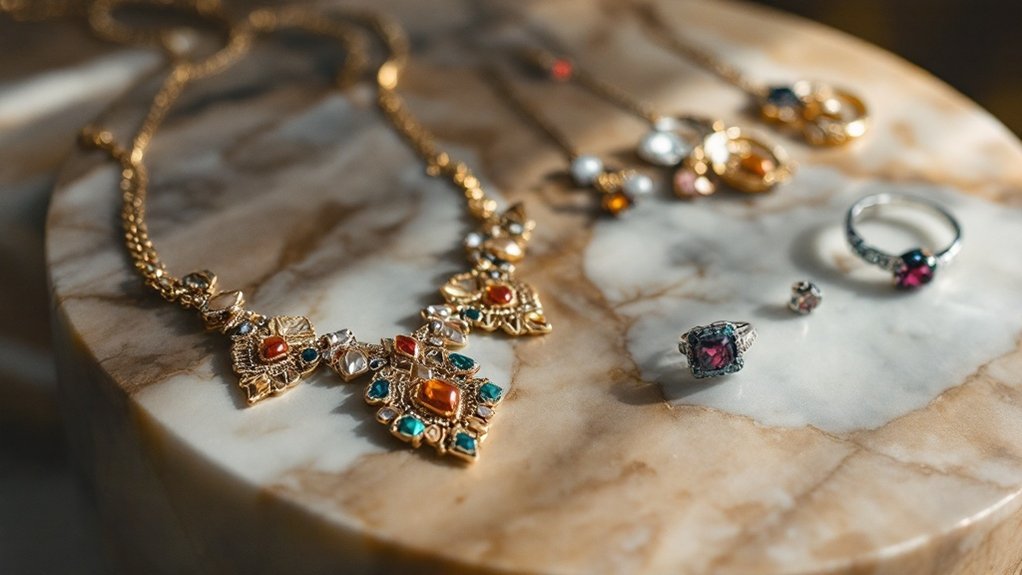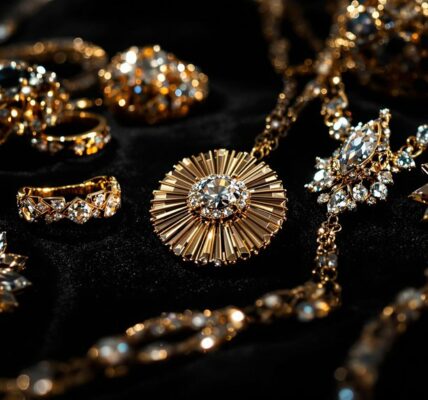Consider a designer like Alice Thompson, who integrates 3D printing with traditional metalsmithing techniques to craft bespoke, eco-friendly jewellery. This combination of old and new raises fascinating questions about how technology redefines artistry and craftsmanship in jewellery design.
Contemporary designers are not just creating pieces; they’re shaping a narrative that reflects personal and environmental values. These designers are challenging industry norms with an increasing focus on sustainable materials and ethical sourcing. What impact will this have on consumer expectations and the future of the jewellery market?
Article Contents
Modern Masters Shaping Jewellery Design
Today’s jewellery designers are redefining the boundaries of their craft through pioneering techniques and artistic ingenuity. Feng J leads this creative revolution, whose trailblazing Floating Set technique has transformed how gemstones are presented, creating an ethereal effect that challenges traditional design constraints.
This commitment to artistic expression is echoed in the work of David Michael Jewels, who masterfully combines vivid colours with complex yet feminine forms. These designers often incorporate vibrant coloured stones in place of traditional diamonds to create distinctive signature pieces. The movement draws inspiration from Bauhaus aesthetics, emphasising clean lines and functional simplicity in modern pieces.
Design advancements continue to shape the field as contemporary masters adopt both traditional and unconventional materials. The sculptural approach to jewellery making, influenced by abstract expressionism, has given rise to pieces that transcend mere adornment to become wearable art.
Designers like Art Smith have enhanced the craft by exploring fluid forms in metal, while Peter Macchiarini’s modernist influence continues to inspire today’s creators. These artisans expertly combine geometric shapes with organic patterns, expanding the limits of jewellery design possibilities.
Sustainable Practices in Contemporary Jewellery
Contemporary jewellery designers are leading a transformative movement in sustainable practices, with recycled metals and repurposed materials taking centre stage in their collections. Many sustainable brands like Brilliant Earth and Aurate ensure their pieces are made with 100% recycled gold, demonstrating the industry’s commitment to environmental stewardship.
By opting for metals that are sourced from Fairmined-certified mines, these designers not only minimise environmental impact but also support ethical labour practices. The widespread adoption of lab-grown diamonds and gemstones has revolutionised the industry’s approach to ethical sourcing, offering conscious consumers alternatives that match the beauty of mined stones.
Today’s most influential designers have established rigorous sourcing standards that prioritise environmental responsibility and fair labour practices, setting new benchmarks for excellence in sustainable luxury.
Recycled Materials Revolution
A growing number of contemporary jewellery designers are embracing the “Recycled Materials Revolution” by integrating sustainable practices into their creations. They’re leveraging the potential of recycled metals like gold and silver, which substantially reduce environmental impact by eliminating the need for new mining and conserving natural resources. This shift supports the circular economy, where materials are reused, reducing waste and promoting sustainability.
By opting for recycled metals, designers not only minimise habitat destruction and pollution but also align with consumer demand for transparency and ethical sourcing. The impact of traditional mining practices is profound, causing habitat destruction, water pollution, and considerable carbon emissions. Mining activities lead to deforestation and destruction of natural habitats, affecting wildlife and local ecosystems. In contrast, recycling metals from old jewellery and electronics helps conserve precious resources.
Palladium, known for its durability and resistance to tarnish, emerges as a sustainable choice with its recyclability enhancing its appeal.
Consumer interest in ethical jewellery has surged, with searches for ethical jewellery increasing by 197% from 2018 to 2021. Advances in eco-friendly manufacturing technologies and stricter regulations are further reducing the environmental footprint of jewellery production.
Consumer awareness is rising, with searches for sustainable jewellery surging by 1,434% from 2018 to 2022. This trend signifies a growing desire for freedom from the environmental burden of traditional practices, driving a revolution in contemporary jewellery design.
Lab-Cultivated Stone Adoption
With the jewellery industry undergoing a significant transformation, lab-grown stones are swiftly gaining traction as a sustainable alternative to mined gems. The market dynamics reveal a remarkable shift: by February 2024, lab-grown diamonds captured a 53% market share, highlighting growing consumer acceptance. This surge reflects a broader trend, with sales of lab-grown diamonds soaring to £12 billion in 2022, marking a 38% increase from the previous year.
Major brands like Pandora and Swarovski have adopted this shift, launching collections that appeal to eco-conscious consumers. Lab-grown stones offer guilt-free luxury, addressing ethical and environmental concerns associated with traditional mining. Younger buyers, valuing sustainability and transparency, gravitate towards these gems, attracted by their superior clarity and colour at more affordable prices. Celebrities and influencers further propel this trend by endorsing lab-grown stones, enhancing their desirability and market penetration.
As natural diamond prices fell by 12.34% in April 2024, the appeal of lab-grown alternatives continues to rise, challenging traditional market dynamics. Economically, the industry experiences profound changes. Lab-grown diamonds, with gross margins up to 65%, outperform natural stones. Moreover, these stones possess the same physical and chemical qualities as their natural counterparts, making them an attractive option for consumers seeking authenticity.
The widened price gap, where 1-carat lab-grown diamonds cost 80% less, reshapes revenue models and inventory strategies for retailers. This burgeoning sector’s rise signifies a trend and a redefined jewellery landscape.
Ethical Sourcing Standards
As the jewellery industry adopts lab-grown stones for their sustainability, attention also turns to the broader ethical sourcing standards shaping modern jewellery design. Ethical sourcing principles are increasingly essential, demanding supply chain transparency and regulatory compliance to guarantee materials are responsibly sourced.
Collaboration with eco-friendly companies enhances sustainability commitments, ensuring that the jewellery industry continues to promote fair trade practices and ethical standards. Certifications like Fairtrade Gold and the Kimberley Process play a pivotal role in maintaining these standards, guaranteeing that the jewels adorning contemporary pieces uphold ethical values. The jewellery sector faces challenges such as supply chain complexity, which makes traceability difficult and requires innovative solutions for sustainable practices.
In the quest for freedom from environmental degradation, designers accept recycling and upcycling, breathing new life into old jewellery and reducing the demand for new mining. This approach not only minimises environmental impact but also supports fair labour practices by guaranteeing safe working conditions and fair wages.
Transparency and traceability in the supply chain prevent illicit activities and the use of conflict materials, fostering trust and integrity.
Community engagement remains a cornerstone of ethical sourcing, with fair trade practices promoting local economic growth and safeguarding human rights. As consumer awareness grows, the demand for responsibly sourced jewellery intensifies, pushing the industry towards sustainable production methods.
Consequently, ethical sourcing standards enhance the essence of contemporary jewellery design, merging beauty with responsibility.
Technology Meets Traditional Craftsmanship
In the domain of contemporary jewellery, technology and traditional craftsmanship are no longer adversaries but partners in innovation. Through digital design tools like 3D modelling and augmented reality, designers achieve unprecedented precision and creativity, crafting intricate structures that once seemed impossible.
With the rise of modern-day heirloom pieces, consumers are increasingly viewing their jewellery purchases as investments, focusing on high-quality items that hold meaning and durability. This synergy not only redefines the concept of luxury, emphasising craftsmanship and personal narratives, but also expands artistic boundaries, allowing for a seamless blend of historical techniques and modern advancements. As a result, reputable jewelers are shifting their focus towards creating timeless pieces that transcend passing trends, appealing to consumers who value heritage and long-lasting value. By honouring the traditions of the past while embracing innovation, these jewelers are able to cater to a discerning audience that seeks authenticity and authenticity in their purchases. This approach also fosters a deeper connection between the consumer and the jeweler, as they are not just selling a product, but a meaningful and enduring story.
Online customisation tools allow customers to select materials, stones, and designs, creating a more personalised and interactive shopping experience.
Digital Design Tools Evolve
Digital design tools are revolutionising the jewellery industry by merging cutting-edge technology with traditional craftsmanship. This Design Evolution is driven by Tool Advancements that offer unprecedented capabilities. Tools like Blender, Jewellery CAD Dream, and Matrix Gold empower designers with versatile modelling options. Blender excels in creating intricate details and complex forms, while Jewellery CAD Dream integrates seamlessly with 3D printing, accelerating the creative process.
Matrix Gold, with its parametric design capabilities, guarantees precision and exact measurements, crucial for exquisite jewellery pieces. These digital tools provide Efficiency, dramatically speeding up workflows and enabling designers to focus on creativity rather than repetitive tasks. With AI tools generating and refining designs, the possibilities become boundless. Advanced rendering engines in tools like Matrix Gold provide realistic previews without additional software, ensuring designers can visualise the final product accurately.
Precision and Customisation are at the forefront, allowing designers to create unique pieces tailored to individual client desires. The integration of these tools with 3D printing machines facilitates rapid prototyping, streamlining the path from concept to creation. The transformation in the jewellery industry is palpable, as traditional craftsmanship isn’t replaced but augmented by these innovations. By automating mundane tasks, artisans can dedicate more time to the creative aspects of their craft, guaranteeing that each piece remains a tribute to both art and technology.
Often, contemporary jewellery challenges traditional notions of jewellery as mere adornment, showcasing the artist’s vision and creative expression.
Merging Old With New
The jewellery industry finds itself at a fascinating crossroads where technology intersects with time-honoured craftsmanship. This convergence, known as Artistic Fusion, represents a Craftsmanship Evolution where traditional methods like hand-forging are improved by modern innovations such as 3D modelling and CAD.
These tools allow artisans to create intricate designs, like filigree, with unprecedented precision and speed. Contemporary Jewellery often emphasises creativity and individuality, making it a playground for artisans to blend artistic expression with technical prowess. Detailed digital versions of pieces enable personalisation while maintaining artistry, reaching customers far beyond local markets through e-commerce. As designers act as mediators between traditional techniques and modern technologies, handmade processes continue to create unique, irreplicable pieces that hold emotional and cultural value.
Innovative materials like wood, acrylic, and even recycled elements are being incorporated, reflecting a shift towards sustainability and ethical practices. Machine-aided processes and 3D printing have revolutionised filigree techniques, offering unique, experimental pieces that align with contemporary values.
This blend of old and new invites a sophisticated audience to adopt jewellery that reflects individuality and creativity.
Design evolution in jewellery highlights a blend of traditional and modern aesthetics. Filigree, with its timeless elegance, merges with modern forms to create distinctive textures.
Consumers now actively seek unique pieces that tell personal stories, supporting independent designers and preserving traditional techniques. This dynamic interplay between past and present amplifies the art of jewellery making, offering freedom and innovation.
Cultural Influences and Global Impact
Global influences have seamlessly woven their way into contemporary jewellery design, sparking a vibrant fusion of cultural elements that enrich the art form. Through cultural exchange and inspiration, diverse traditions converge, leading to a period of global appreciation. African culture, for example, has left an indelible mark with its vibrant colours, intricate beadwork, and bold patterns, now celebrated worldwide.
Artists incorporate traditional materials like cowrie shells and bone, paying homage to African heritage while crafting modern masterpieces. These designs often feature cultural symbolism, such as animal representations and tribal motifs, creating pieces that resonate deeply with wearers. The use of recycled metals and ethically sourced gemstones has become increasingly prevalent, reflecting a commitment to sustainable and ethical practices within contemporary jewellery design.
The evolution of jewellery trends reflects a broader societal shift towards individual expression and freedom from conventional norms. Contemporary designers blend Eastern and Western styles, crafting unique and culturally rich pieces that captivate a global audience. Techniques, materials, and motifs used in jewellery making are passed down through generations, preserving cultural heritage and identity. This fusion not only amplifies the artistic appeal but also underscores a universal desire for connection and understanding.
As contemporary jewellery becomes a medium for artistic expression, designers push boundaries with unconventional materials and sustainable practices. Their creations, embodying both innovation and respect for tradition, offer wearers a chance to express their personal style while honouring cultural significance. This transformative art form continues to evolve, celebrating diversity and inspiring global appreciation.
Materials and Manufacturing Evolution
Jewellery design has undergone a remarkable transformation with the evolution of materials and manufacturing techniques. Designers are now embracing the freedom to experiment with recycled materials, like metals and plastics, to craft unique, meaningful pieces that champion sustainability.
The use of fair-trade and conflict-free gemstones, along with lab-created alternatives, highlights a commitment to ethical sourcing, offering transparency and reducing environmental impact. Innovative textiles and advanced alloys have expanded the creative horizons of contemporary jewellery design.
Non-traditional materials like synthetic gemstones, titanium, and biodegradable elements challenge conventional craftsmanship, contributing a unique flair to the collections. Jewellery remains a symbol of status, personal expression, or art across different cultures, reflecting its enduring historical significance. By applying traditional processing techniques to these modern materials, designers forge a mesmerising blend of the past and future. On the manufacturing front, technologies like laser cutting and engraving lend precision and speed to intricate designs.
Automation and robotics improve efficiency, ensuring consistent quality and minimal human error. CAD/CAM technology streamlines the creation of virtual prototypes, allowing for unprecedented customisation and experimentation. As these advancements continue to evolve, they empower jewellery artists to redefine boundaries, crafting pieces that eloquently speak to the desires of a sophisticated, freedom-seeking audience. Advanced technology enhances minute details and precision, increasing the accuracy of designs and improving the overall quality of finished products.
Digital Innovation in Jewellery
Amidst a rapidly evolving technological landscape, digital innovation is reshaping the jewellery industry by introducing groundbreaking tools and methods. At the forefront of this transformation are AI trends and virtual showrooms, revolutionising how designers and consumers interact with jewellery.
Artificial Intelligence analyses consumer preferences, predicting upcoming styles whilst generating unique designs through generative algorithms. This not only refines the creative process but also improves the jewellery’s appeal to modern buyers. Contemporary jewellery, recognised for its unique designs, leverages digital tools to push creative boundaries even further.
Virtual showrooms, leveraging augmented reality, provide a contactless shopping experience, allowing customers to virtually try on jewellery. This innovation empowers consumers, offering the freedom to examine collections from anywhere, whilst reducing the need for physical prototypes and returns—an eco-friendly benefit. Moreover, the resurgence of men’s jewellery as a significant trend has been facilitated by these technological advancements, allowing designers to cater to a broader audience with diverse tastes.
Technological advancements like 3D printing and CAD have further streamlined production. 3D printing enables rapid prototyping, minimising material waste and fostering creativity. CAD offers precise, customisable designs, boosting collaboration between designers and clients. Meanwhile, blockchain guarantees transparency and authenticity, certifying sustainable practices.
E-commerce platforms and AI-driven design software offer personalised experiences, integrating seamlessly with manufacturing processes. Through these digital transformations, the jewellery industry isn’t only becoming more efficient but also more inclusive and sustainable, heralding a new age of artistry.
Market Trends and Consumer Preferences
Emphasising sustainability and ethical sourcing is increasingly reshaping the jewellery market, responding to the growing demand for eco-friendly materials and lab-grown diamonds. This trend reflects a shift in consumer behaviour, as 67% of buyers expect jewellery to express personality whilst aligning with ethical values. In response to these demands, the growth of second-hand and vintage jewellery markets is also gaining traction, reflecting a broader consumer interest in sustainable practices and unique pieces.
In this evolving landscape, market segmentation reveals diverse preferences. Traditional styles captivate 44% of consumers, whereas minimalistic designs appeal to 20%, highlighting the importance of varied offerings. Additionally, 64% of consumers believe that symbols in jewellery convey emotion or offer protection, indicating a significant influence on purchasing decisions.
The jewellery market’s growth is fuelled by these sustainable practices, with eco-conscious consumers seeking pieces that embody both style and responsibility. Lab-grown diamonds and recycled materials cater to this demand, offering guilt-free luxury.
Meanwhile, design trends such as minimalist, vintage, and bold statement pieces capture distinct consumer segments, ensuring that there’s something for everyone.
Demographic influences further shape market trends, with Gen Z gravitating towards embellished designs and the Silver Generation driving luxury spending. Understanding these nuances in consumer behaviour allows for targeted marketing strategies, enhancing brand appeal across generations and income brackets.
Ultimately, the jewellery market thrives on its ability to adapt, offering consumers the freedom to choose designs that resonate with their values and aspirations.




